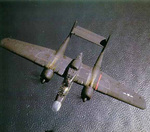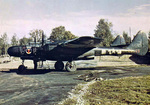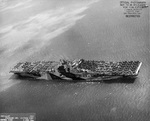P-61 Black Widow
| Country | United States |
| Manufacturer | Northrop Corporation |
| Primary Role | Night Fighter |
| Maiden Flight | 21 May 1942 |
Contributor: C. Peter Chen
ww2dbaseThe P-61 Black Widow night fighters were designed by Jack Northrop as a response to the British need for night fighters that carried radar, equipped with multiple gun turrets, and could remain in the air for at least eight hours. The resulting purpose-built, all-metal, twin-engine, twin-boom, monoplane design, however, was submitted to the United States Army Air Corps instead of the British Royal Air Force after Northrop realized the US Army had a similar need. On 5 Nov 1940, Northrop and his research chief Vladimir H. Pavlecka defeated Douglas Aircraft Company's design in a competition, which led to the 5 Dec US Army approval of the P-61 Black Widow design, which in turn led to the 10 Jan 1941 contract for two prototypes. On 2 Apr, the Air Corps Mockup Board reviewed the prototype mock up and moved the wing-mounted 20-mm Hispano M2 cannon to the lower section of the fuselage, which eliminated aiming difficulties associated with convergence; a positive side-effect of this was the clearing of wing space for additional fuel capacity of over 100 gallons. The prototype took flight in May 1942, and production commenced later that year.
ww2dbaseAfter training conducted in Florida and California, United States, P-61 Black Widow aircraft were deployed to the front lines. The United States Army Air Forces' 422nd Night Fighter Squadron was the first to complete their training in Florida, and was deployed to England, Britain in Feb 1944, followed shortly after by the 425th Night Fighter Squadron. When the crews of the two squadrons arrived in England, however, they found they were without their P-61 aircraft. Then, in May 1944, USAAF generals began expressing concerns that the P-61 aircraft were too slow to effectively perform in the night fighter role. Many in the Royal Air Force agreed, suggesting the use of Mosquito night fighters instead. At the end of May 1944, the USAAF held a competition between 422nd Night Fighter Squadron-manned P-61 night fighters and RAF-manned Mosquito Mk XVI night fighters to determine whether the P-61 aircraft were to remain in service over Britain and elsewhere; the results were very close, with the Americans considering the P-61 to be slightly better while the RAF thought otherwise.
ww2dbaseWith the capability confirmed by the competition held in England in May, the 6th Night Fighter Squadron of the USAAF at Guadalcanal received their first P-61 Black Widow night fighters in the next month. The first P-61 operation took place on 25 Jun 1944, and the first kill, a Japanese G4M bomber, was achieved on 30 Jun. The P-61 night fighters continued to serve in the Pacific War through 1944, defending against night time raids.
ww2dbaseIn late Jun 1944, the 422nd Night Fighter Squadron finally received their P-61 aircraft. By mid-Jul, they were patrolling the British skies. Their first action took place on 15 Jul when Lieutenant Herman Ernst's P-61 Black Widow night fighter attempted to intercept a V-1 rocket; Ernst failed the mission after the plastic rear cone imploded during the attack. On the very next day, Ernst was directed to intercept another V-1 rocket; he was successful in this second attempt, scoring the first kill for the 422nd Night Fighter Squadron. In early Aug 1944, the 422nd and 425th Night Fighter Squadrons were transferred to Maupertus, France. In the same month, they began engaging German aircraft, shooting down a Bf 110 and a Fw 190 shortly afterwards. In Dec 1944, P-61 night fighters of the two squadrons performed daylight ground attack missions against German supply lines during the Ardennes offensive that later came to be known as the Battle of the Bulge. By early 1945, combat engagements with German aircraft became rare as Allied air superiority became nearly total.
ww2dbaseOn 30 Jan 1945, a lone P-61 aircraft performed ground attack mission against a Japanese prisoner of war camp at Cabanatuan, Philippine Islands. The attack was diversionary; the purpose was to distract the Japanese so that American commandos could infiltrate the camp to rescue the 500 Allied POWs imprisoned there.
ww2dbaseIn terms of aerial combat, the P-61 Black Widow night fighters assigned to the Pacific War experienced a similar situation in 1945 as their European counterparts, where engagements with Japanese aircraft became sporadic. Several squadrons equipped with these night fighters claimed no kills during 1945. However, P-61 aircraft "Lady in the Dark" of the 548th Night Fighter Squadron, piloted by Lieutenant Lee Kendall, downed two of the last few Japanese aircraft of the Pacific War, which were a Ki-43 and a Ki-44 aircraft during the nights of 14 and 15 Aug, respectively (the last two kills, two A6M Zero fighters, were achieved by crew of the B-32 Dominator bomber "Hobo Queen Two", on 18 Aug 1945).
ww2dbaseAfter the war, P-61 Black Widow aircraft remained in USAAF service, largely due to the USAAF's inability to quickly produce a modern jet-powered replacement. Starting in early 1948, the process to phase them out began, with the last front-line aircraft being withdrawn in May 1950. The last US Air Force P-61 Black Widow aircraft retired from operational service in 1952. Before they were retired, however, they participated in the Thunderstorm Project between 1946 and 1949, which was critical in the scientific understanding of thunderstorms.
ww2dbaseDuring the design's production life, 742 were built.
ww2dbaseSource: Wikipedia.
Last Major Revision: Sep 2007
P-61 Black Widow Timeline
| 21 May 1942 | Northrop P-61 Black Widow night fighter took flight for the first time. |
SPECIFICATIONS
P-61
| Machinery | Two Pratt & Whitney R-2800-65 Double Wasp radial engines with water injection, rated at 2,250hp each |
| Armament | 4x20mm Hispano M2 cannon in ventral fuselage, 4x12.7mm Browning M2 machine guns in upper turret, optional 2x726kg bombs, optional 6x127mm HVAR rockets |
| Crew | 3 |
| Span | 20.12 m |
| Length | 15.11 m |
| Height | 4.47 m |
| Wing Area | 61.53 m² |
| Weight, Empty | 10,637 kg |
| Weight, Loaded | 13,471 kg |
| Weight, Maximum | 16,420 kg |
| Speed, Maximum | 589 km/h |
| Rate of Climb | 12.90 m/s |
| Service Ceiling | 10,600 m |
| Range, Normal | 982 km |
| Range, Maximum | 3,060 km |
Photographs
 |  |  |  |
Você gostou deste artigo ou achou este artigo útil? Se sim, considere nos apoiar no Patreon. Qualquer valor já vai ajudar! Obrigado. Por favor, ajude-nos a divulgar o site: Fique atualizado com WW2DB: |
Visitor Submitted Comments
8 Feb 2012 11:55:53 AM
I live in northern california and I collect antique aircraft toys. Last year I went to an anitique store in Fortuna California and Bought a wooden replica of the Black widow. The owner of the store told me that it was carved by a black widow pilot himself. I was wondering if anyone may know of a ww2 vet/pilot who may have carved this. He lives in Northern california, and I am happy to say I have kept the cool little plane on my fire place. If anyone has information about the man who may have hand carved this, please let me know. Thanks
11 Feb 2012 11:46:21 AM
One of these days I should forward you a pic of the hand carved p-61, I'm on vacation now but When I get back I will take a pic and post it. Its real neat. I do believe there were mission numbers on the wing and an aircraft serial number on the side and tail
28 Aug 2012 05:20:32 PM
I'm currently in the 548 CTS, our roots come from the 548 NFS. We still carry on the name-sake and still display 'Scopie' the blackcat with smoking six shooter and flashlight. I'm trying to find an artist print/rendering of Lady of the Night. We want to frame and use as a squadron going away gift.
28 Aug 2012 05:22:02 PM
Sorry I meant Lady in the Dark.
17 Nov 2012 04:17:03 PM
Hi,
I live less than a mile from the first ETO base of the 422/425 during WW2, RAF Charmy Down in Spring of 44. I have a nice series of pictures of the airfield, much of which is still standing including the control tower and several earth bomb blast dispersals. If you'd like pictures mail me.
I also have a video I made of the station with my brother.
24 Feb 2013 06:45:43 PM
I did a book on the 421st NFS and the P-61, but still would love to find a photo of the 547th Bird "Pandora's Box" and also information on the Navy's Catapult Testing with the P-61 (Info/photos) let me hear from you.
31 Mar 2013 07:13:40 PM
i just recieved the clock that was in the ready room for the 422nd nfs in europe , it was given by the family of stan condon,pilot of the 422nd p61 - stan told me about the clock for years - he was a good friend - neat piece of history -just a note ! ,thanks,ron
23 Jun 2013 07:04:51 PM
Anyone needing NFS leather unit patches,I make them,see samples of various patches here,
http://s1334.photobucket.com/user/EMBLEMHUNTER/library/Patches
WeBeEmblems@aol.com
31 Mar 2021 10:47:48 PM
My grandfather was a crew member on a P-61 NFS in China. They got lost on a mission, ran out of fuel, and had to ditch over China. He survived. I’m just looking for a report, records or additional information on the incident. Where could I find that potentially? Thanks
3 Jul 2021 02:34:56 AM
My daddy was WWII Pacific theater crew member NFS located in Guam and Philippines. His P-61 was named "The Plastered Bastard"...
9 Jun 2022 11:35:16 AM
Tommy What was "The Plastered Bastard" serial number?
All visitor submitted comments are opinions of those making the submissions and do not reflect views of WW2DB.

- » The Emperor of Japan Planned to Honor WW2-era Japanese POWs in Mongolia (4 Jul 2025)
- » US State Lawmaker John Winter Caught Using Racial Slur "Jap" and Apologized (11 Jun 2025)
- » Köln/Cologne Evacuated After Discovery of WW2 Bombs (4 Jun 2025)
- » Race, Holocaust, and African-American WW2 Histories Removed from the US Naval Academy Library (7 Apr 2025)
- » US Government Plans to Purge WW2 Information (17 Mar 2025)
- » Ver todas as notícias
 |
- » 1,178 biografias
- » 337 eventos
- » 45,081 entradas na linha do tempo
- » 1,245 navios
- » 350 modelos de aeronaves
- » 207 modelos de veículos
- » 376 modelos de armas
- » 123 documentos históricos
- » 261 instalações
- » 470 eventos
- » 28,491 fotos
- » 365 mapas
James Forrestal, Secretary of the Navy, 23 Feb 1945
Por favor, considere nos apoiar no Patreon. Mesmo R$1 por mês já faz uma grande diferença. Obrigado!
Ou, por favor, nos apoie adquirindo alguns produtos do WW2DB na TeeSpring. Obrigado!
28 Jun 2011 11:37:59 AM
During the late stages of WW2, I worked summer jobs at a near-by AFB. Since I was a skilled Radio mech, I held both security clearance and knowledge/clearance to work on RADAR! This meant that all B-29s and P-61s that were on base, on my shift, fell under my inspection. Thus, the bird you have under reconstruction could have been one that I cleared for combat... Actually, there is probably no way of telling, but, I would like to take a look...
See you soon..
Raymond F Krueger